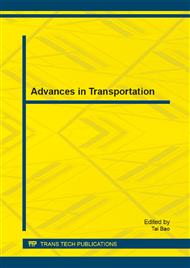p.537
p.542
p.548
p.554
p.558
p.562
p.567
p.571
p.577
The Study of Feeder Bus Network Optimization Model
Abstract:
In order to study the optimal network of feeder bus lines for rail stations, this paper established an optimization model with the objective of minimizing the consume time and operating costs of unit traveler, and proposed an iterative algorithm to solve the model and then used an example to describe the practicality of the model and the algorithm.
Info:
Periodical:
Pages:
558-561
Citation:
Online since:
January 2014
Authors:
Keywords:
Price:
Сopyright:
© 2014 Trans Tech Publications Ltd. All Rights Reserved
Share:
Citation:


